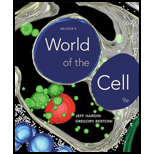
(a)
To determine: The electron donor and an electron acceptor in the given system along with the most likely pathway of electron transport in a system where mitochondria were incubated with β-hydroxybutyrate, oxidized cytochrome c, ADP, Pi, and cyanide.
Introduction: Electron transport system (ETS) is comprised of a number of complexes that carry electron from its donors to its acceptors. ETS joins this transfer of electrons with the transfer of H+ ions across the mitochondrial membranes. The whole process of ETS drives the mechanism of ATP synthesis.
(b)
To determine: The number of moles of ATP that would be formed per mole of β-hydroxybutyrate oxidized, and write a balanced equation for the reaction that occurs in the given system where mitochondria were incubated with β-hydroxybutyrate, oxidized cytochrome c, ADP, Pi, and cyanide.
Introduction: Electron transport system (ETS) is comprised of a number of complexes that carry electron from its donors to its acceptors. ETS joins this transfer of electrons with the transfer of H+ ions across the mitochondrial membranes. The whole process of ETS drives the mechanism of ATP synthesis.
(c)
To explain: The purpose of adding cyanide to the system and the possible results if cyanide was not added in the reaction system where mitochondria were incubated with β-hydroxybutyrate, oxidized cytochrome c, ADP, Pi, and cyanide.
Introduction: Electron transport system (ETS) is comprised of a number of complexes that carry electron from its donors to its acceptors. ETS joins this transfer of electrons with the transfer of H+ ions across the mitochondrial membranes. The whole process of ETS drives the mechanism of ATP synthesis.
(d)
To explain: Whether the enzymes of the citric acid cycle would be active in the assay where mitochondria were incubated with β-hydroxybutyrate, oxidized cytochrome c, ADP, Pi, and cyanide, giving the reason for the same.
Introduction: Electron transport system (ETS) is comprised of a number of complexes that carry electron from its donors to its acceptors. ETS joins this transfer of electrons with the transfer of H+ ions across the mitochondrial membranes. The whole process of ETS drives the mechanism of ATP synthesis.
(e)
To explain: The importance of β-ketobutyrate not being
Introduction: Electron transport system (ETS) is comprised of a number of complexes that carry electron from its donors to its acceptors. ETS joins this transfer of electrons with the transfer of H+ ions across the mitochondrial membranes. The whole process of ETS drives the mechanism of ATP synthesis.
Want to see the full answer?
Check out a sample textbook solution
Chapter 10 Solutions
Becker's World of the Cell (9th Edition)
- In one paragraph show how atoms and they're structure are related to the structure of dna and proteins. Talk about what atoms are. what they're made of, why chemical bonding is important to DNA?arrow_forwardWhat are the structure and properties of atoms and chemical bonds (especially how they relate to DNA and proteins).arrow_forwardThe Sentinel Cell: Nature’s Answer to Cancer?arrow_forward
- Molecular Biology Question You are working to characterize a novel protein in mice. Analysis shows that high levels of the primary transcript that codes for this protein are found in tissue from the brain, muscle, liver, and pancreas. However, an antibody that recognizes the C-terminal portion of the protein indicates that the protein is present in brain, muscle, and liver, but not in the pancreas. What is the most likely explanation for this result?arrow_forwardMolecular Biology Explain/discuss how “slow stop” and “quick/fast stop” mutants wereused to identify different protein involved in DNA replication in E. coli.arrow_forwardMolecular Biology Question A gene that codes for a protein was removed from a eukaryotic cell and inserted into a prokaryotic cell. Although the gene was successfully transcribed and translated, it produced a different protein than it produced in the eukaryotic cell. What is the most likely explanation?arrow_forward
- Molecular Biology LIST three characteristics of origins of replicationarrow_forwardMolecular Biology Question Please help. Thank you For E coli DNA polymerase III, give the structure and function of the b-clamp sub-complex. Describe how the structure of this sub-complex is important for it’s function.arrow_forwardMolecular Biology LIST three characteristics of DNA Polymerasesarrow_forward
 BiochemistryBiochemistryISBN:9781305577206Author:Reginald H. Garrett, Charles M. GrishamPublisher:Cengage Learning
BiochemistryBiochemistryISBN:9781305577206Author:Reginald H. Garrett, Charles M. GrishamPublisher:Cengage Learning Biology 2eBiologyISBN:9781947172517Author:Matthew Douglas, Jung Choi, Mary Ann ClarkPublisher:OpenStax
Biology 2eBiologyISBN:9781947172517Author:Matthew Douglas, Jung Choi, Mary Ann ClarkPublisher:OpenStax Concepts of BiologyBiologyISBN:9781938168116Author:Samantha Fowler, Rebecca Roush, James WisePublisher:OpenStax College
Concepts of BiologyBiologyISBN:9781938168116Author:Samantha Fowler, Rebecca Roush, James WisePublisher:OpenStax College Human Physiology: From Cells to Systems (MindTap ...BiologyISBN:9781285866932Author:Lauralee SherwoodPublisher:Cengage Learning
Human Physiology: From Cells to Systems (MindTap ...BiologyISBN:9781285866932Author:Lauralee SherwoodPublisher:Cengage Learning



